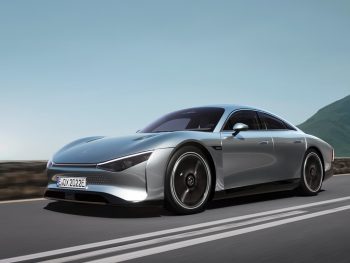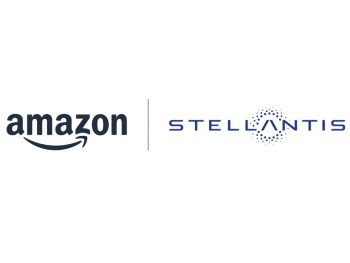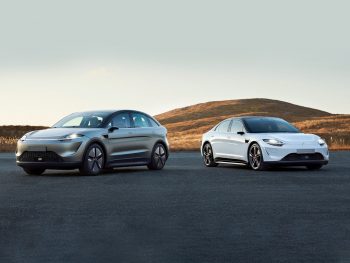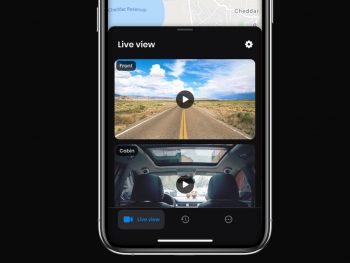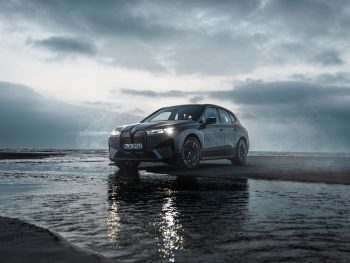CES 2022: The highlights for fleets
One of the world’s biggest tech trade exhibitions, the annual Consumer Electronics Show (CES) is also an increasingly influential event on the auto calendar. Fleet World reports back on the main highlights of this year’s event.
In the ever-increasing convergence between the automotive and technology worlds, the CES event is now a major platform for the latest vehicle innovations. From prototypes and concept vehicles, through to latest in-vehicle tech, services and telematics solutions, it’s all been previewed here in recent years.
The 2020 event, the last physical CES event, saw Sony reveal its Vision S rival to the Tesla Model S while the Fisker Ocean SUV made its debut and Honda showed an augmented driving concept.
After a hiatus last year due to Covid that saw the event go online, CES returned to run in-person for 2022 in Las Vegas – albeit on a smaller scale than previous years and running for one day less – and provided a latest glimpse of the cars and technologies that could shape car fleets in the future.
Mercedes-Benz Vision EQXX
Mercedes-Benz revealed its Vision EQXX concept, previewing its future electric vehicles.
Basically an EV saloon with a claimed real-world range of more than 620 miles (1,000 km) on a single charge, the prototype “demonstrates just how efficient, sustainable and luxurious electromobility can be”.
It also shows precisely what will make an electric vehicle a Mercedes-Benz in the future, according to the brand, with lightweight design, battery innovations and new materials.
The drivetrain has claimed world-leading efficiency; 95% of the energy stored in the battery reaches the wheels, compared to around 30% for an ICE vehicle and apparently 50% for an average human long-distance runner.
It also debuts new battery tech with significantly improved energy density that enables it to store 100kWh, whilst taking up 50% less space and weighing 30% less than batteries with comparable capacity, such as in the EQS.
Across the board, efficiency engineering achievements deliver an energy consumption of more than 6 miles per kWh (less than 10kWh per 100km).
It’s expected to provide the basis for cars arriving from 2024 onwards.
Amazon and Stellantis tie-up on new in-car tech
Amazon and Stellantis announced that they will collaborate on new “customer-centric” in-car technologies.
The firms have signed a series of global, multi-year agreements that they say will transform the in-vehicle experience and “create the foundation for Stellantis to transform from a traditional automaker into a global leader in software-driven development and engineering”.
The collaboration will cover the full Stellantis portfolio of 14 vehicle brands and will focus on several areas. These include work to deliver software solutions for Stellantis’ new digital cabin platform, STLA SmartCockpit, starting in 2024. This will be used in millions of vehicles, providing AI-enhanced applications for entertainment, Alexa-enabled voice assistance, navigation, vehicle maintenance, ecommerce marketplaces and payment services. These can be adapted to customers’ behaviours and interests.
Integration with Amazon’s smart home and security services will also allow customers to proactively monitor and manage their homes while on the go. Stellantis customers will also be able to manage their vehicles from their Alexa-enabled devices at home or their Alexa smartphone app, including using custom Alexa skills to set the in-cabin temperature before getting into their vehicle, schedule service, or order accessories.
As part of the agreement, Stellantis has selected Amazon Web Services (AWS) as its preferred cloud provider for vehicle platforms. Together, Stellantis and Amazon plan to build the next generation of cloud-enabled infrastructure for vehicle platforms, including for STLA SmartCockpit.
In a separate agreement, Amazon will become the first commercial customer for the new Ram ProMaster Battery Electric Vehicle (BEV) in 2023, further expanding its sustainable delivery network in the US. The business already uses thousands of Stellantis commercial vehicles for its delivery services.
Sony Vision-S 02 prototype revealed
At CES 2022, Sony announced and exhibited an SUV-type prototype vehicle, dubbed Vision-S 02 and potentially heralding its expansion to become a vehicle maker.
The brand had already put a toe in the water with its Vision-S unveiling at the 2020 show, equipped with 33 sensors to enable self-driving and safety functions, along with a large panoramic screen and Sony speakers in the cabin. Since then, the vehicle has undergone testing in Europe and Japan.
Speaking at the unveiling of the new prototype, Sony CEO Kenichiro Yoshida said the company was “well positioned” to redefine mobility and announced that a new company, Sony Mobility Inc, will be established in the spring to accelerate work in this area.
The new prototype builds on these plans. Based on the same platform as the Vision-S, the seven-seat, fully electric SUV again uses a pair of 272hp motors, giving four-wheel drive and a combined 543hp of power.
Nextbase reveals world’s ‘first truly smart dash cam’
Dash cam specialist Nextbase revealed its new iQ solution, said to be the world’s first fully connected smart dash cam.
It’s designed to fast-track next-generation safety, security and AI-driver assistance.
Thanks to its AI-powered technology, the iQ delivers new features, such as Spatial Awareness, where the dash cam anticipates, records and notifies the user of incidents when away from the vehicle. The new Roadwatch AI provides instant, accurate monitoring of other vehicles’ speeds and trajectories, and with Witness Mode, iQ offers immediate handsfree recording, as well as real-time cloud upload and sharing to provide the “ultimate” video evidence.
The all-new Nextbase IQ app gives users real-time alerts and access to video when away from their vehicle. Drivers can benefit from real time tracking with ultra-precise GPS, smart sense parking for enhanced monitoring of surroundings, and instant incident notifications including still snapshot visualisation.
It also carries over key dash cam features from existing Nextbase tech, including 4K three-camera, video technology; able to record both externally and internally.
The iQ will launch in autumn 2022.
BMW iX M60 makes world premiere
BMW once again revealed a number of new innovations at CES, albeit with all media activities livestreamed from Germany.
The main highlight was the unveiling of the iX M60 – a new flagship version of its iX electric SUV and the first BMW model to have received its world premiere at CES.
Using a dual-motor four-wheel drive set-up, the iX M60 develops 1,100Nm of torque and 620hp of power, making it “the ultimate driving machine” according to the brand. It will sprint from 0-62mph in 3.8 seconds and has a limited top speed of 155mph.
It also sets standards in the areas of user experience, operation and connectivity among others, as well as with its automated driving and parking functions, according to the brand.
The range-topping iX will launch in summer 2022, priced from £111,905 and bringing a rival to the Model X.
BMW also revealed new ‘My Modes’ in-car user experiences, including a Digital Art Mode presents digital art in an automobile for the first time and a Theatre Mode said to herald a new era for in-car entertainment.
The carmaker also demonstrated new colour-changing car tech on a special version of its iX SUV. The iX Flow uses a specially developed body wrap based on electrophoretic display technology. When stimulated by electrical signals, the technology brings different colour pigments to the surface – something that could be used to suit drivers’ aesthetic preferences or even to tailor a vehicle to corporate branding.
It could even support reduced use of fuel consumption and electric range – by changing to a darker outer skin in cooler weather or a lighter colour in hot conditions, the technology could help to cut the amount of cooling and heating required from the vehicle’s air conditioning and benefiting fuel or electricity consumption.
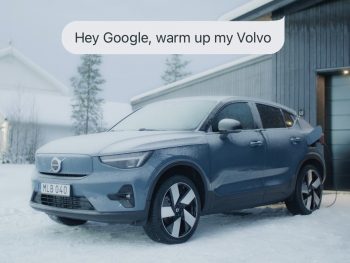 Volvo enhances connected tech, safety and autonomous driving
Volvo enhances connected tech, safety and autonomous driving
Volvo revealed a number of developments relating the in-car experience, safety and autonomous driving.
This includes an enhanced tie-up with Google that will make it the first car maker to directly integrate its cars with Google Assistant-enabled devices.
This planned direct integration will enable customers to control functions in their car by issuing voice commands to Google Assistant-enabled home and mobile devices. By pairing their Volvo car with their Google account, customers can directly talk to Google in their car and remotely control a variety of functionalities, such as warming it up on a cold winter day or locking the car.
Planned future functionalities include charging scheduling, which allows customers to set specific times when they want their car to start charging, and more.
“Volvo Car Group was first to introduce Google technology and services in our cars, and we are now looking to be the first to integrate fully with Google Assistant-enabled devices – it is a natural next step in our partnership with Google,” said Henrik Green, Chief Product Officer at Volvo Cars. “This integration allows us to improve the customer experience immensely, because it gives customers the possibility to easily and securely manage their car while at home or on the go, through any personal device that has Google Assistant.”
In addition, YouTube video playback will come to all Volvo cars with Google built-in.
YouTube will be the first video platform to be featured and available for download in Volvo cars on Google Play, spearheading a move to enable video streaming in Volvo cars.
Videos will only be able to be played when the car is fully stationary; for example when electric vehicles are charging.
Volvo will also use Qualcomm’s Snapdragon Cockpit Platforms to power its Google Android Automotive-based infotainment system in upcoming fully electric cars under the Volvo and Polestar brands. The companies will improve the overall capability of Volvo’s next-generation infotainment system powered by Google Android, making it much faster and more responsive. The collaboration includes future improvements that will be rolled out over the air.
Volvo also revealed that it will introduce its unsupervised autonomous driving feature, Ride Pilot, to customers in the state of California first.
Once it has been verified as safe for use on highways, Ride Pilot is planned to be available as an add-on subscription on the company’s forthcoming fully electric SUV, due to be revealed later this year.
The software is developed by autonomous driving (AD) software company Zenseact together with Volvo Cars’ in-house team of developers, and developers from Luminar, one of its technology partners.

Hyundai’s new PnD module is a single-wheel robotics platform that combines intelligent steering, braking, in-wheel electric drive and suspension hardware that can be scaled up or down, for any purpose, size or application
Hyundai presents future of mobility
Hyundai Motor shared its vision on how robotics will be used to fulfil “unlimited freedom of mobility” in both the real world and metaverse under the theme ‘Expanding Human Reach’.
The carmaker said robotics was an essential part of its transformation into a smart mobility solution provider, following its acquisition last year of American engineering and robotics design company Boston Dynamics.
Hyundai will now develop a new ‘Metamobility’ concept, using robotics as a medium between the real and virtual worlds. It gave an example of how a worker would interact with a robotic avatar in the metaverse via a VR interface and hand controls to manipulate things in the real world using a proxy robot at the remote work site.
Hyundai also revealed its Plug & Drive (PnD) and Drive & Lift (DnL) modular platforms as all-in-one solutions for its unlimited Mobility of Things (MoT) ecosystem. Examples of uses for its PnD module include providing freedom of movement for people with disabilities, automated logistics, reconfigurable interior space and public transportation with individual compartments for social distancing and last-mile mobility.
Blink Charging launches new EV charging products for fleets
Blink Charging launched seven new electric vehicle charging products at CES, spanning home, fleet, multifamily and retail charging.
The new products include the MQ 200, HQ 200 (Smart and Basic models), Vision IQ 200, and 50kW DC Fast Charger.
Some charging products also feature a new vehicle-to-grid technology capable of dynamically balancing energy demand with supply.
In addition, Blink revealed two new apps, Blink Mobile App and the Blink Fleet portal, to enable a more efficient and affordable charging experience for both consumers and fleets.
“With the launch of this next-generation of products, Blink is leading a paradigm shift in what charging infrastructure is and can be,” said Michael D Farkas, founder and CEO of Blink Charging.
“Pairing more than a decade’s worth of industry experience with the newest charging technology available in the market, we have built products that create reliable and enjoyable charging experiences for customers across the industry. By taking this holistic approach to electrification, reaching consumers, fleets, businesses, retailers, developers, and municipalities, we are making transitioning to EVs easier than ever before, while also helping to deliver on the electrification goals set forth by both public and private entities globally.”


